Luminescent Materials for Dye-Sensitized Solar Cells: Advances and Directions
Abstract
:1. Introduction
2. Fundamental Principles
2.1. Working Operation
2.2. Photovoltaic Effect in DSSCs
- I.
- Light Absorption: The dye molecules absorb incident photons, leading to their excitation:The excited has an electron promoted to a higher energy state.
- II.
- Electron Injection: The excited electron is injected into the conduction band of TiO2:This leaves the dye in an oxidized state (Dye⁺).
- III.
- Electron Transport: The injected electrons diffuse through the TiO2 nanoparticles to the fluorine-doped tin oxide (FTO) layer and flow through an external circuit, generating electrical power:Electrons travel through the TiO2, move to the FTO, flow through the external circuit, and finally reach the counter electrode.
- IV.
- Dye Regeneration: The oxidized dye is reduced back to its ground state by the redox mediator in the electrolyte:
- V.
- Electrolyte Regeneration: The tri-iodide () formed is reduced back to iodide ions (I−) through gaining electrons at the counter electrode:
2.3. Equivalent Circuit Model of DSSCs
3. Methods
4. Luminescent Materials in DSSCs
4.1. Up-Conversion
4.2. Down-Conversion
4.3. Quantum Dots
4.4. Advances and Research
4.5. Energy Transfer
4.6. Mechanism of Energy Transfer
- Quantum Dots as Donors: Quantum dots (QDs), due to their size-tunable emission properties, are excellent candidates for FRET applications in DSSCs. For instance, CdSe QDs can be engineered to emit light in the visible spectrum, overlapping well with the absorption spectra of many commonly used dyes, such as N719 or perovskites [91]. This overlap facilitates efficient energy transfer, enhancing the photoexcitation of the dye molecules and potentially increasing the photocurrent.
- Lanthanide-Doped Nanoparticles: Lanthanide-doped nanoparticles exhibit sharp emission peaks and long-lived excited states, making them suitable for FRET applications. Materials doped with lanthanides like Eu3+ or Tb3+ can emit visible light after absorbing UV light, effectively transferring energy to the dye molecules in DSSCs [92].
4.7. How to Incorporate Luminescent Materials in DSSCs
- Activity 1: Preparation of Photo-anode
- Mix the TiO2 nanomaterial with a suitable solvent to synthesize TiO2 paste.
- Incorporate the synthesized luminescent material to the TiO2 paste (either in varying concentrations or just the optimum concentration of the luminescent material) to study its effect on the photo-anode performance.
- Anneal the photo-anode at appropriate temperatures to remove the binder and enhance adhesion.
- Activity 2: Sensitization with Dye
- Immerse the annealed photo-anode in the dye solution for a few hours to allow thorough dye adsorption.
- Depending on the focus of the study, you could optimize dye loading conditions, such as concentration and immersion time, to maximize the light absorption capabilities.
- Activity 3: Cell Assembly
- Pair the sensitized photo-anode with a platinum-coated counter electrode to form a sandwich.
- Fill the inter-electrode space with a liquid electrolyte containing iodide/tri-iodide redox couple.
- Seal the cells to prevent electrolyte leakage and ensure stable operation.
- Finally, measure the photovoltaic current density—voltage performance of the device under standard solar illumination (Air Mass = 1.5 G) to determine the photovoltaic power conversion efficiency of the device.
5. Discussion
6. Conclusions
Author Contributions
Funding
Institutional Review Board Statement
Informed Consent Statement
Data Availability Statement
Acknowledgments
Conflicts of Interest
References
- Fébba, D.M.; Rubinger, R.; Oliveira, A.; Bortoni, E. Impacts of temperature and irradiance on polycrystalline silicon solar cells parameters. Sol. Energy 2018, 174, 628–639. [Google Scholar] [CrossRef]
- Isabela, C.B.; Lameirinhas RA, M.; Torres JP, N.; Fernandes, C.A. Comparative study of the copper indium gallium selenide (CIGS) solar cell with other solar technologies. Sustain. Energy Fuels 2021, 5, 2273–2283. [Google Scholar]
- Shah, A. Amorphous silicon solar cells. In Solar Cells and Modules; Springer: Berlin/Heidelberg, Germany, 2020; pp. 139–161. [Google Scholar]
- Park, S.; Simon, J.; Schulte, K.L.; Ptak, A.J.; Wi, J.-S.; Young, D.L.; Oh, J. Germanium-on-nothing for epitaxial liftoff of GaAs solar cells. Joule 2019, 3, 1782–1793. [Google Scholar] [CrossRef]
- Başol, B.M.; McCandless, B. Brief review of cadmium telluride-based photovoltaic technologies. J. Photonics Energy 2014, 4, 040996. [Google Scholar] [CrossRef]
- Kamat, P.V. Meeting the clean energy demand: Nanostructure architectures for solar energy conversion. J. Phys. Chem. C 2008, 112, 18737–18753. [Google Scholar] [CrossRef]
- O’Regan, B.; Grätzel, M. A low-cost, high-efficiency solar cell based on dye-sensitized colloidal TiO2 films. Nature 1991, 353, 737–740. [Google Scholar] [CrossRef]
- Hagfeldt, A.; Boschloo, G. Dye-sensitized solar cells. Chem. Rev. 2010, 110, 6595–6663. [Google Scholar] [CrossRef]
- Nazeeruddin, M.K.; Kay, A.; Rodicio, I.; Humphry-Baker, R.; Müller, E.; Liska, P.; Vlachopoulos, N.; Grätzel, M. Conversion of light to electricity by cis-X2bis(2,2′-bipyridyl-4,4′-dicarboxylate)ruthenium(II) charge-transfer sensitizers (X = Cl-, Br-, I-, CN-, and SCN-) on nanocrystalline titanium dioxide electrodes. J. Am. Chem. Soc. 1993, 115, 6382–6390. [Google Scholar] [CrossRef]
- Grätzel, M. Dye-sensitized solar cells. J. Photochem. Photobiol. C Photochem. Rev. 2003, 4, 145–153. [Google Scholar] [CrossRef]
- Mathew, S.; Yella, A.; Gao, P.; Humphry-Baker, R.; Curchod, B.F.; Ashari-Astani, N.; Tavernelli, I.; Rothlisberger, U.; Nazeeruddin, M.K.; Grätzel, M. Dye-sensitized solar cells with 13% efficiency achieved through the molecular engineering of porphyrin sensitizers. Nat. Chem. 2014, 6, 242–247. [Google Scholar] [CrossRef]
- Mozaffari, S.; Nateghi, M.R.; Zarandi, M.B. An overview of the Challenges in the commercialization of dye sensitized solar cells. Renew. Sustain. Energy Rev. 2017, 71, 675–686. [Google Scholar] [CrossRef]
- Ebenezer Anitha, A.; Dotter, M. A review on liquid electrolyte stability issues for commercialization of dye-sensitized solar cells (DSSC). Energies 2023, 16, 5129. [Google Scholar] [CrossRef]
- Sharma, K.; Sharma, V.; Sharma, S.S. Dye-sensitized solar cells: Fundamentals and current status. Nanoscale Res. Lett. 2018, 13, 1–46. [Google Scholar] [CrossRef]
- Andualem, A.; Demiss, S. Review on dye-sensitized solar cells (DSSCs). Edelweiss Appl. Sci. Technol. 2018, 2, 145–150. [Google Scholar] [CrossRef]
- Vlachopoulos, N.; Hagfeldt, A.; Benesperi, I.; Freitag, M.; Hashmi, G.; Jia, G.; Dietzek, B. New approaches in component design for dye-sensitized solar cells. Sustain. Energy Fuels 2021, 5, 367–383. [Google Scholar] [CrossRef]
- Jiang, R.; Michaels, H.; Vlachopoulos, N.; Freitag, M. Beyond the limitations of dye-sensitized solar cells. In Dye-Sensitized Solar Cells; Academic Press: Cambridge, MA, USA, 2019; pp. 285–323. [Google Scholar]
- Khir, H.; Pandey, A.K.; Saidur, R.; Ahmad, M.S.; Abd Rahim, N.; Dewika, M.; Samykano, M. Recent advancements and challenges in flexible low temperature dye sensitised solar cells. Sustain. Energy Technol. Assess. 2022, 53, 102745. [Google Scholar] [CrossRef]
- Bandara TM, W.J.; Hansadi JM, C.; Bella, F. A review of textile dye-sensitized solar cells for wearable electronics. Ionics 2022, 28, 2563–2583. [Google Scholar] [CrossRef]
- Yella, A.; Lee, H.W.; Tsao, H.N.; Yi, C.; Chandiran, A.K.; Nazeeruddin, M.K.; Diau, E.W.; Yeh, C.Y.; Zakeeruddin, S.M.; Grätzel, M. Porphyrin-sensitized solar cells with cobalt (II/III)–based redox electrolyte exceed 12 percent efficiency. Science 2011, 334, 629–634. [Google Scholar] [CrossRef]
- Hosseini, Z.; Huang, W.K.; Tsai, C.M.; Chen, T.M.; Taghavinia, N.; Diau, E.W.G. Enhanced light harvesting with a reflective luminescent down-shifting layer for dye-sensitized solar cells. ACS Appl. Mater. Interfaces 2013, 5, 5397–5402. [Google Scholar] [CrossRef]
- Rajeswari, R.; Islavath, N.; Raghavender, M.; Giribabu, L. Recent progress and emerging applications of rare earth doped phosphor materials for dye-sensitized and perovskite solar cells: A review. Chem. Rec. 2020, 20, 65–88. [Google Scholar] [CrossRef]
- Park, C.-H.; Kim, T.H.; Yonesaki, Y.; Kumada, N. A re-investigation of the crystal structure and luminescence of BaCa2MgSi2O8: Eu2+. J. Solid State Chem. 2011, 184, 1566–1570. [Google Scholar] [CrossRef]
- Kim, K.; Nam, S.K.; Moon, J.H. Dual-band luminescent solar converter-coupled dye-sensitized solar cells for high-performance semitransparent photovoltaic device. ACS Appl. Energy Mater. 2020, 3, 5277–5284. [Google Scholar] [CrossRef]
- Yao, N.; Huang, J.; Fu, K.; Deng, X.; Ding, M.; Xu, X. Rare earth ion doped phosphors for dye-sensitized solar cells applications. RSC Adv. 2016, 6, 17546–17559. [Google Scholar] [CrossRef]
- Xie, G.; Lin, J.; Wu, J.; Lan, Z.; Li, Q.; Xiao, Y.; Yue, G.T.; Yue, H.F.; Huang, M. Application of upconversion luminescence in dye-sensitive solar cells. Chin. Sci. Bull. 2011, 56, 96–101. [Google Scholar] [CrossRef]
- Bella, F.; Griffini, G.; Gerosa, M.; Turri, S.; Bongiovanni, R. Performance and stability improvements for dye-sensitized solar cells in the presence of luminescent coatings. J. Power Sources 2015, 283, 195–203. [Google Scholar] [CrossRef]
- Hosseini, Z.; Taghavinia, N.; Wei-Guang Diau, E. Luminescent Spectral Conversion to Improve the Performance of Dye-Sensitized Solar Cells. ChemPhysChem 2017, 18, 3292–3308. [Google Scholar] [CrossRef]
- Huang, X.; Han, S.; Huang, W.; Liu, X. Enhancing solar cell efficiency: The search for luminescent materials as spectral converter. Chem. Soc. Rev. 2013, 42, 173–201. [Google Scholar] [CrossRef] [PubMed]
- Liu, J.; Yao, Q.; Li, Y. Effects of down-conversion luminescent film in dye-sensitive solar cells. Appl. Phys. Lett. 2006, 88, 173119. [Google Scholar] [CrossRef]
- Griffini, G.; Bella, F.; Nisic, F.; Dragonetti, C.; Roberto, D.; Levi, M.; Bongiovanni, R.; Turri, S. Multifunctional luminescent down-shifting fluoropolymer coatings: A straightforward strategy to improve the UV-light harvesting ability and long-term outdoor stability of organic dye-sensitized solar cells. Adv. Energy Mater. 2015, 5, 1401312. [Google Scholar] [CrossRef]
- McKenna, B.; Evans, R.C. Towards efficient spectral converters through materials design for luminescent solar devices. Adv. Mater. 2017, 29, 1606491. [Google Scholar] [CrossRef]
- Li, Q.; Lin, J.; Wu, J.; Lan, Z.; Wang, Y.; Peng, F.; Huang, M. Improving photovoltaic performance of dye-sensitized solar cell by downshift luminescence and p-doping effect of Gd2O3: Sm3+. J. Lumin. 2013, 134, 59–62. [Google Scholar] [CrossRef]
- Rehman, A.U.; Aslam, M.; Khan, M.; Shahid, I.; Siddiq, A.; Iqbal, M.A.; Ahmed, S. Enhancing the photovoltaic performance of solid-state dye-sensitive solar cells with composite materials and luminescent down-shifting. J. Electron. Mater. 2020, 49, 6292–6299. [Google Scholar] [CrossRef]
- He, W.; Atabaev, T.S.; Kim, H.K.; Hwang, Y.H. Enhanced sunlight harvesting of dye-sensitized solar cells assisted with long persistent phosphor materials. J. Phys. Chem. C 2013, 117, 17894–17900. [Google Scholar] [CrossRef]
- Liang, L.; Yulin, Y.; Mi, Z.; Ruiqing, F.; LeLe, Q.; Xin, W.; Zhang, L.; Zhou, X.; Jianglong, H. Enhanced performance of dye-sensitized solar cells based on TiO2 with NIR-absorption and visible upconversion luminescence. J. Solid State Chem. 2013, 198, 459–465. [Google Scholar] [CrossRef]
- Klampaftis, E.; Ross, D.; McIntosh, K.R.; Richards, B.S. Enhancing the performance of solar cells via luminescent down-shifting of the incident spectrum: A review. Sol. Energy Mater. Sol. Cells 2009, 93, 1182–1194. [Google Scholar] [CrossRef]
- Li, J.; Yin, O.; Zhao, L.; Wang, Z.; Dong, B.; Wan, L.; Wang, S. Enhancing theelectric photoelectric conversion efficiency of dye-sensitized solar cell using the upconversion luminescence materials Y2O3: Er3+ nanorods of TiO2 photoanode. Mater. Lett. 2018, 227, 209–212. [Google Scholar] [CrossRef]
- Bai, J.; Duan, P.; Wang, X.; Han, G.; Wang, M.; Diao, G. Upconversion luminescence enhancement by Fe3+ doping in CeO2: Yb/Er nanomaterials and their application in dye-sensitized solar cells. RSC Adv. 2020, 10, 18868–18874. [Google Scholar] [CrossRef]
- Zhang, Y.; Pan, K.; Qu, Y.; Wang, G.; Dai, Q.; Wang, D.; Qin, W. Luminescent material with functionalized carbon nitride as a photovoltaic booster in DSSCs: Enhanced charge separation and transfer. J. Mater. Res. 2019, 34, 616–625. [Google Scholar] [CrossRef]
- Wang, T.H.; Huang, T.W.; Tsai, Y.C.; Chang, Y.W.; Liao, C.S. A photoluminescent layer for improving the performance of dye-sensitized solar cells. Chem. Commun. 2015, 51, 7253–7256. [Google Scholar] [CrossRef]
- Muthu, S.; Gandhi, M.B.; Meenakshi Flooded, S.P.; Gandhi, S.K.; Sridharan, M.B.; Park, H.J.J. A Review on the Applicability of Luminescent Phosphors and Effective Positioning in Dye-Sensitized Solar Cells for Enhanced Performance and Stability. Sol. RRL 2023, 7, 2300510. [Google Scholar] [CrossRef]
- Kumar, V.; Swami, S.K.; Kumar, A.; Ntwaeaborwa, O.M.; Dutta, V.; Swart, H.C. Eu3+ doped down shifting TiO2 layer for efficient dye-sensitized solar cells. J. Colloid Interface Sci. 2016, 484, 24–32. [Google Scholar] [CrossRef] [PubMed]
- Yuliantini, L.; Nursam, N.M.; Pranoto, L.M.; Hidayat, J.; Sova, R.R.; Rahayu, E.S.; Djamal, M.; Yasaka, P.; Boonin, K.; Kaewkhao, J. Photon up-conversion in Er3+ ion-doped ZnO-Al2O3-BaO-B2O3 glass for enhancing the performance of dye-sensitized solar cells. J. Alloys Compounds 2023, 954, 170163. [Google Scholar] [CrossRef]
- Kakiage, K.; Aoyama, Y.; Yano, T.; Oya, K.; Fujisawa, J.I.; Hanaya, M. Highly-efficient dye-sensitized solar cells with collaborative sensitization by silyl-anchor and carboxy-anchor dyes. Chem. Commun. 2015, 51, 15894–15897. [Google Scholar] [CrossRef]
- Yum, J.H.; Baranoff, E.; Wenger, S.; Nazeeruddin, M.K.; Grätzel, M. Panchromatic engineering for dye-sensitized solar cells. Energy Environ. Sci. 2011, 4, 842–857. [Google Scholar] [CrossRef]
- Rho, W.Y.; Jeon, H.; Kim, H.S.; Chun, W.J.; Suh, J.S.; Jun, B.H. Recent progress in dye-sensitive solar cells for improving efficiency: TiO2 nanotube arrays in active layer. J. Nanomater. 2015, 16, 85. [Google Scholar]
- Kusama, H.; Orita, H.; Sugihara, H. TiO2 band shift by nitrogen-containing heterocycles in dye-sensitized solar cells: The periodic density functional theory study. Langmuir 2008, 24, 4411–4419. [Google Scholar] [CrossRef]
- Ansari, A.A.; Nazeeruddin, M.K.; Tavakoli MM, M. Organic-inorganic upconversion nanoparticles hybrid in dye-sensitivezed solar cells. Coord. Chem. Rev. 2021, 436, 213805. [Google Scholar] [CrossRef]
- Li, Q.; Lin, J.; Wu, J.; Lan, Z.; Wang, J.; Wang, Y.; Peng, F.; Huang, M.; Xiao, Y. Preparation of Gd2O3:Eu3+ downconversion luminescent material and its application in dye-sensitized solar cells. Chin. Sci. Bull. 2011, 56, 3114–3118. [Google Scholar] [CrossRef]
- Chebrolu, V.T.; Kim HJ, J. Recent progress in quantum dot sensitized solar cells: An inclusive review of photoanode, sensitive, electrolyte, and the electro-fighter. J. Mater. Chem. C 2019, 7, 4911–4933. [Google Scholar] [CrossRef]
- Shen, J.; Li, Z.; Cheng, R.; Luo, Q.; Luo, Y.; Chen, Y.; Chen, X.; Sun, Z.; Huang, S. Eu3+-doped NaGdF4 nanocrystal down-converting layer for efficient dye-sensitized solar cells. ACS Appl. Mater. Interfaces 2014, 6, 17454–17462. [Google Scholar] [CrossRef]
- Yao, N.; Huang, J.; Fu, K.; Deng, X.; Ding, M.; Shao, M.; Xu, X. Enhanced light harvesting of dye-sensitized solar cells with up/down conversion materials. Electrochim. Acta 2015, 154, 273–277. [Google Scholar] [CrossRef]
- Wang, J.; Du, Z.; Hojamberdiev, M.; Zheng, S.; Xu, Y. Oxalate-assisted morphological effect of NaYF4: Yb3+, Er3+ on photoelectrochemical performance for dye-sensitive solar cells. J. Rare Earths 2018, 36, 353–358. [Google Scholar] [CrossRef]
- Luo, X.; Ahn, J.Y.; Kim, S.H. Aerosol synthesis and luminescent properties of CaAl2O4: Eu2+, Nd3+ down-conversion phosphor particles for enhanced light harvesting of dye-sensitized solar cells. Sol. Energy 2019, 178, 173–180. [Google Scholar] [CrossRef]
- Kamal, R.; Hafez, H. Novel Down-converting single-phased white light Pr3+ doped BaWO4 Nanophosphors material for DSSC applications. Opt. Mater. 2021, 121, 111646. [Google Scholar] [CrossRef]
- Mao, X.; Yu, J.; Xu, J.; Wan, L.; Yang, Y.; Lin, H.; Zhou, R. Commercial Upconversion Phosphors with High Light Harvesting: A Superior Candidate for High-Performance Dye-Sensitized Solar Cells. Phys. Status Solidi (a) 2019, 216, 1900382. [Google Scholar] [CrossRef]
- Dutta, J.; Rai VK, K. Upconverting BiYO3 nanophosphors in DSSCs applications. Opt. Laser Technol. 2021, 140, 107087. [Google Scholar] [CrossRef]
- Tadge, P.; Yadav, R.S.; Vishwakarma, P.K.; Rai, S.B.; Chen, T.M.; Sapra, S.; Ray, S. Enhanced photovoltaic performance of Y2O3: Ho3+/Yb3+ upconversion nanophosphor based DSSC and investigation of color tunability in Ho3+/Tm3+/Yb3+ tri-doped Y2O3. J. Alloys Compounds 2020, 821, 153230. [Google Scholar] [CrossRef]
- Fang, X.; Li, M.; Guo, K.; Li, J.; Pan, M.; Bai, L.; Luosha, M.; Zhao, X. Graphene quantum dots optimization of dye-sensitized solar cells. Electrochim. Acta 2014, 137, 634–638. [Google Scholar] [CrossRef]
- Kundu, S.; Sarojinijeeva, P.; Karthick, R.; Anantharaj, G.; Saritha, G.; Bera, R.; Anandan, S.; Patra, A.; Ragupathy, P.; Selvaraj, M.; et al. Enhas thencing the Efficiency of DSSCs by the Modification of TiO2 Photoanodes using N, F and S, co-doped Graphene Quantum Dots. Electrochim. Acta 2017, 242, 337–343. [Google Scholar] [CrossRef]
- Chou, J.C.; Syu, R.H.; Yang, P.H.; Kuo, P.Y.; Nien, Y.H.; Lai, C.H.; Chen, P.F.; Wu, Y.T.; Zhuang, S.W. Graphene quantum dots a co-sensitive with improving light absorption for dye-sensitized solar cells. IEEE Trans. Nanotechnol. 2023, 22, 20–27. [Google Scholar] [CrossRef]
- Rajeswari, R.; Susmitha, K.; Jayasankar, C.K.; Raghavender, M.; Giribabu, L. Enhanced light harvesting with novel photon upconverted Y2CaZnO5: Er3+/Yb3+ nanophosphors for dye sensitized solar cells. Sol. Energy 2017, 157, 956–965. [Google Scholar] [CrossRef]
- Chouryal, Y.N.; Sharma, R.K.; Tomar, N.; Yadav, N.; Kewat, H.L.; Wani, I.A.; Nigam, S.; Surolia, P.K.; Sivakumar, S.; Ghosh, P. Upconverted Nanophosphors for Increasing Efficiency in a Dye-Sensitized Solar Cell. ACS Appl. Energy Mater. 2023, 6, 4934–4941. [Google Scholar] [CrossRef]
- Ambapuram, M.; Ramireddy, R.; Maddala, G.; Godugunuru, S.; Yerva, P.V.S.; Mitty, R. Effective upconverter and light scattering dual function LiYF4: Er3+/Yb3+ assisted photoelectrode for high performance cosensitized dye sensitized solar cells. ACS Appl. Electron. Mater. 2020, 2, 962–970. [Google Scholar] [CrossRef]
- Li, Q.; Lin, J.; Wu, J.; Lan, Z.; Wang, Y.; Peng, F.; Huang, M. Enhancing photovoltaic performance of dye-sensitized solar cell by rare-earth doped oxide of Lu2O3:(Tm3+, Yb3+). Electrochim. Acta 2011, 56, 4980–4984. [Google Scholar] [CrossRef]
- Morassaei MSalehabadi, A.; Akbari, A.; Tavassoli, S.H.; Salavati-Niasari, M. Enhanced dye sensitized solar cells efficiency by utilization of an external layer of CaCe2(MoO4)4: Er3+/Yb3+ nanoparticles. J. Alloys Compounds 2018, 769, 732–739. [Google Scholar] [CrossRef]
- Du, P.; Lim, J.H.; Leem, J.W.; Cha, S.M.; Yu, J.S. Enhanced photovoltaic performance of dye-sensitized solar cells by efficient near-infrared sunlight harvesting using upconverting Y2O3: Er3+/Yb3+ phosphor nanoparticles. Nanoscale Res. Lett. 2015, 10, 321. [Google Scholar] [CrossRef]
- Dutta, J.; Rai, V.K.; Durai, M.M.; Thangavel, R. Development of Y2O3:Ho3+/Yb3+ upconverting nanophosphors for enhancing solar cell efficiency of dye-sensitized solar cells. IEEE J. Photovolt. 2019, 9, 1040–1045. [Google Scholar] [CrossRef]
- Qin, Y.; Hu, Z.; Lim, B.H.; Chang, W.S.; Chong, K.K.; Zhang, P.; Zhang, H. Sol-hydrothermal synthesis of TiO2: Sm3+ nanoparticles and their enhanced photovoltaic properties. J. Alloys Compounds 2016, 686, 803–809. [Google Scholar] [CrossRef]
- Zahedifar, M.; Chamanzadeh, Z.; Madani, M.; Moradi, M.; Sharifpour, N. Synthesis and characterization of GdVO4: Dy 3+ nanosheets as down converter: Application in dye-sensitized solar cells. J. Mater. Sci. Mater. Electron. 2016, 27, 4447–4456. [Google Scholar] [CrossRef]
- Chamanzadeh, Z.; Sharifpour, N.; Zahedifar, M.; Madani, M. Synthesis of CeVO4: Dy3+ Nanoparticles as Down Converter and Its Application for Efficiency Enhancement in Dye-Sensitized Solar Cells. J. Nanostructures 2023, 13, 811–825. [Google Scholar]
- Shen, Z.; Jin, S.; Hao, H.; Hou, H.; Zhang, G.; Bi, J.; Liu, G. Synthesis and characterization of Sm3+-doped barium stannate down-conversion nanocrystals and its application in dye-sensitized solar cells. Mater. Chem. Phys. 2019, 230, 215–220. [Google Scholar] [CrossRef]
- Zahedifar, M.; Chamanzadeh, Z.; Mashkani, S.H. Synthesis of LaVO4: Dy3+ luminescent nanostructure and optimization of its performance as down-converter in dye-sensitized solar cells. J. Lumin. 2013, 135, 66–73. [Google Scholar] [CrossRef]
- Llanos, J.; Brito, I.; Espinoza, D.; Sekar, R.; Manidurai, P. A down-shifting Eu3+-doped Y2WO6/TiO2 photoelectrode for improved light harvesting in dye-sensitized solar cells. R. Soc. Open Sci. 2018, 5, 171054. [Google Scholar] [CrossRef] [PubMed]
- Lim, M.J.; Ko, Y.N.; Kang, Y.C.; Jung KY, Y. Enhancement of light-harvesting efficiency of dye-sensitized solar cells via forming TiO2 composite double layers with down/up converting phosphor dispersion. RSC Adv. 2014, 4, 10039–10042. [Google Scholar] [CrossRef]
- Maaouni, N.; Rosaiah, P.; Kumar, K.G.; Dhanalakshmi, M.A.; Albaqami, M.D.; Ayub, R. Enhanced DSSC efficiency through integration of red-emitting MgAl2O4: Eu3+ phosphor within TiO2 layer. Opt. Mater. 2024, 151, 115349. [Google Scholar] [CrossRef]
- Chen, E.Z.; Gu, X.Y.; Wei, K.; Cheng, Y.; Chen, Z.L.; Sun, G.Z.; Pan, X.J.; Zhou, J.Y.; Xie, E.Q. Role of long persistence phosphors on their enhancement in performances of photoelectric devices: In case of dye-sensitized solar cells. Appl. Surf. Sci. 2020, 507, 145098. [Google Scholar] [CrossRef]
- Que, M.; Que, W.; Yin, X.; Shao, J. Enhanced sunlight harvesting of dye-sensitized solar cells through the insertion of a (Sr, Ba, Eu) 2SiO4-TiO2 composite layer. Mater. Res. Bull. 2016, 83, 19–23. [Google Scholar] [CrossRef]
- Xie, G.; Wu, J.; Lin, J.; Li, Q.; Lan, Z.; Xiao, Y.; Yue, G.; Ye, H.; Huang, M. Improving Photoelectrical Performance of a Dye Sensitized Solar Cell by Doping Rare-earth Oxide Y2O3:(Eu3+, Gd3+). Energy Sources Part A Recovery Util. Environ. Eff. 2012, 34, 1534–1540. [Google Scholar] [CrossRef]
- Teymourinia, H.; Salavati-Niasari, M.; Amiri, O.; Farangi, M. Facile synthesis of graphene quantum dots from corn powder and their application as down-conversion effect in quantum dot-dye-sensitized solar cell. J. Mol. Liq. 2018, 251, 267–272. [Google Scholar] [CrossRef]
- Yuan, H.; Zhao, Y.; Wang, Y.; Duan, J.; He, B.; Tang, Q. Sonochemistry-assisted black/red phosphorus hybrid quantum dots for dye-sensitized solar cells. J. Power Sources 2019, 410, 53–58. [Google Scholar] [CrossRef]
- Zhao, Y.; Duan, J.; He, B.; Jiao, Z.; Tang, Q. Improved charge extraction with N-doped carbon quantum dots in dye-sensitized solar cells. Electrochim. Acta 2018, 282282, 255–262. [Google Scholar] [CrossRef]
- Mahalingam, S.; Manap, A.; Rabeya, R.; Lau, K.S.; Chia, C.H.; Abdullah, H.; Amin, N.; Chelvanathan, P. Electron transport of chemically treated graphene quantum dots-based dye-sensitized solar cells. Electrochim. Acta 2023, 439, 141667. [Google Scholar] [CrossRef]
- Dinari, M.; Momeni, M.M.; Goudarzirad, M. Dye-sensitized solar cells based on nanocomposite of polyaniline/graphene quantum dots. J. Mater. Sci. 2016, 51, 2964–2971. [Google Scholar] [CrossRef]
- Shejale, K.P.; Jaiswal, A.; Kumar, A.; Saxena, S.; Shukla, S. Nitrogen doped carbon quantum dots as Co-active materials for highly efficient dye sensitized solar cells. Carbon 2021, 183, 169–175. [Google Scholar] [CrossRef]
- Basham JIMor, G.K.; Grimes, C.A. Forster resonance energy transfer in dye-sensitive solar cells. ACS Nano 2010, 4, 1253–1258. [Google Scholar] [CrossRef]
- Mor, G.K.; Basham JPaulo, M.; Kim, S.; Varghese, O.K.; Vaish, A.; Grimes, C.A. High-efficiency forster resonance energy transfer in solid-state dye sensitized solar cells. Nano Lett. 2010, 10, 2387–2394. [Google Scholar] [CrossRef]
- Gordon, F.; Elcoroaristizabal, S.; Ryder, A.G. Modelling Forster resonance energy transfer (FRET) using anisotropy solved multi-dimensional emission spectroscopy (ARMES). Biochim. Biophys. Acta (BBA)-Gen. Subj. 2021, 1865, 129770. [Google Scholar]
- Lakowicz, J.R.R. (Ed.) Principles of Fluorescence Spectroscopy; Springer US: Boston, MA, USA, 2006. [Google Scholar]
- Kamat, P.V. Quantum dot solar cells. The next big thing in photovoltaics. J. Phys. Chem. Lett. 2013, 4, 908–918. [Google Scholar] [CrossRef]
- Yuliantini, L.; Paramudita, I.; Pranoto, L.M.; Shobih, S.; Hidayat, J.; Nursam NM, M. Application of Down-conversion Materials based on Trivalent Europium Ion-doped Fluoroborotellurite Glass for Transparent Dye-sensitive Solar Cell. In Proceedings of the 2022 International Conference on Radar, Antenna, Microwave, Electronics, and Telecommunications (ICRAMET), Bandung, Indonesia, 6–7 December 2022; pp. 114–118. [Google Scholar]
- Agrawal, A.; Siddiqui, S.A.; Soni, A.; Khandelwal, K.; Sharma, G.D. Performance analysis of TiO2 based dye sensitized solar cell prepared by screen printing and doctor blade deposition techniques. Sol. Energy 2021, 226, 9–19. [Google Scholar] [CrossRef]
- Raïssi, M.; Pellegrin, Y.; Lefevre, F.X.; Boujtita, M.; Rousseau, D.; Berthelot, T.; Odobel, F. Digital printing of efficient dye-sensitized solar cells (DSSCs). Sol. Energy 2020, 199, 92–99. [Google Scholar] [CrossRef]
- Yildiz, Z.K.; Atilgan, A.B.D.U.L.L.A.H.; Atli, A.; Özel, K.; Altinkaya, C.; Yildiz, A. Enhancement of efficiency of natural and organic dye sensitized solar cells using thin film TiO2 photoanodes fabricated by spin-coating. J. Photochem. Photobiol. A Chem. 2019, 368, 23–29. [Google Scholar] [CrossRef]
- Najm, A.S.; Alwash, S.A.; Sulaiman, N.H.; Chowdhury, M.S.; Techato, K. N719 dye as a sensitizer for dye-sensitized solar cells (DSSCs): A review of its functions and certain rudimentary principles. Environ. Prog. Sustain. Energy 2023, 42, e13955. [Google Scholar] [CrossRef]
- Wang, X.; Bolag, A.; Yun, W.; Du, Y.; Eerdun, C.; Zhang, X.; Bao, T.; Ning, J.; Alata, H.; Ojiyed, T. Enhanced performance of dye-sensitized solar cells based on a dual anchored diphenylpyranylidene dye and N719 co-sensitization. J. Mol. Struct. 2020, 1206, 127694. [Google Scholar] [CrossRef]
- Bera, D.; Qian, L.; Tseng, T.K.; Holloway, P.H. Quantum dots and their multimodal applications: A review. Materials 2010, 3, 2260–2345. [Google Scholar] [CrossRef]
- Lin, Y.; Lin, J.; Chen, J.W.; Hsiao, P.T.; Tung, Y.L.; Chang, C.C.; Chen, C.M.M. Efficiency improvement of dye-sensitized solar cells by in situ fluorescence resonance energy transfer. J. Mater. Chem. A 2017, 5, 9081–9089. [Google Scholar] [CrossRef]
- Mohd Nazree, M.A.N. Reducing Re-Absorption Losses in Luminescent Solar Concentrators (LSC’s) by Using Nanomaterials; IRC: Delft, The Netherlands, 2016. [Google Scholar]
- Liu, Q.; Ding, X.; Pang, Y.; Cao, Y.; Lei, J.; Wu, J.; Zhang, T. New insights into the safety assessment of quantum dots: Potential release pathways, environmental transformations, and health risks. Environ. Sci. Nano 2022, 9, 3277–3311. [Google Scholar] [CrossRef]
- Ren, X.; Zhang, X.; Xie, H.; Cai, J.; Wang, C.; Chen, E.; Guo, T. Perovskite quantum dots for emerging displays: Recent progress and perspectives. Nanomaterials 2022, 12, 2243. [Google Scholar] [CrossRef]
- Ferreira, R.A.; Correia, S.F.; Monguzzi, A.; Liu, X.; Meinardi, F. Spectral converters for photovoltaics–What’s ahead. Mater. Today 2020, 33, 105–121. [Google Scholar] [CrossRef]
- Zhou, D.; Song, H. Phosphors for Solar Cells. In Phosphor Handbook; CRC Press: Boca Raton, FL, USA, 2022; pp. 651–688. [Google Scholar]
- Rehman, A.U.; Khan, M.; Khan, A.D.; Raja, A.A.; Aslam, M.; Khan, S.; Imran, M. The effect of plasmonic multilayered photoanode structures on absorption the of dye-sensitivezed solar cells. Jpn. J. Appl. Phys. 2021, 60, 011004. [Google Scholar] [CrossRef]
- Gnida, P.; Amin, M.F.; Pajok, A.K.; Jarzbek, B. Polymers in High-efficiency solar cells: The latest reports. Polymers 2022, 14, 1946. [Google Scholar] [CrossRef]
- Yun, S.; Qin, Y.; Uhl, A.R.; Vlachopoulos, N.; Yin, M.; Li, D.; Hagfeldt, A. New-generation integrated devices based on dye-sensitized and perovskite solar cells. Energy Environ. Sci. 2018, 11, 476–526. [Google Scholar] [CrossRef]
- Skandalos, N.; Kapsalis, V.; Ma, T.; Karamanis, D. Towards 30% Efficiency by 2030 of Eco-Designed Building Integrated Photovoltaics. Solar 2023, 3, 434–457. [Google Scholar] [CrossRef]
- Yu, G.; Yang, H.; Luo, D.; Cheng, X.; Ansah, M.K. A review on developments and researches of building integrated photovoltaic (BIPV) windows and shading blinds. Renew. Sustain. Energy Rev. 2021, 149, 111355. [Google Scholar] [CrossRef]
- Liu, X.; Wu, Y. Design, development and characterisation of a Building Integrated Concentrating Photovoltaic (BICPV) smart window system. Sol. Energy 2021, 220, 722–734. [Google Scholar] [CrossRef]
- Kant, K.; Shukla, A.; Sharma, A. Use of Building Integrated Photovoltaic (BIPV): A Significant Step toward Green Buildings. In Energy Security and Sustainability; CRC Press: Boca Raton, FL, USA, 2016; pp. 73–110. [Google Scholar]

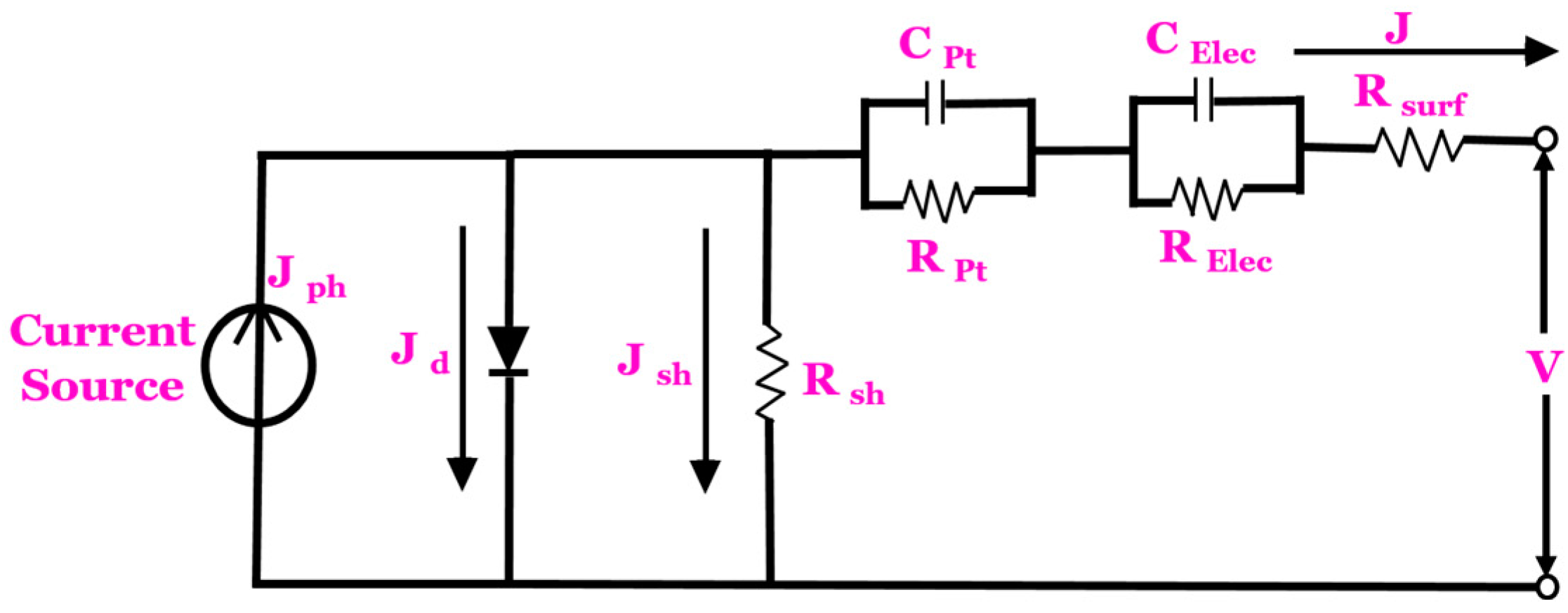
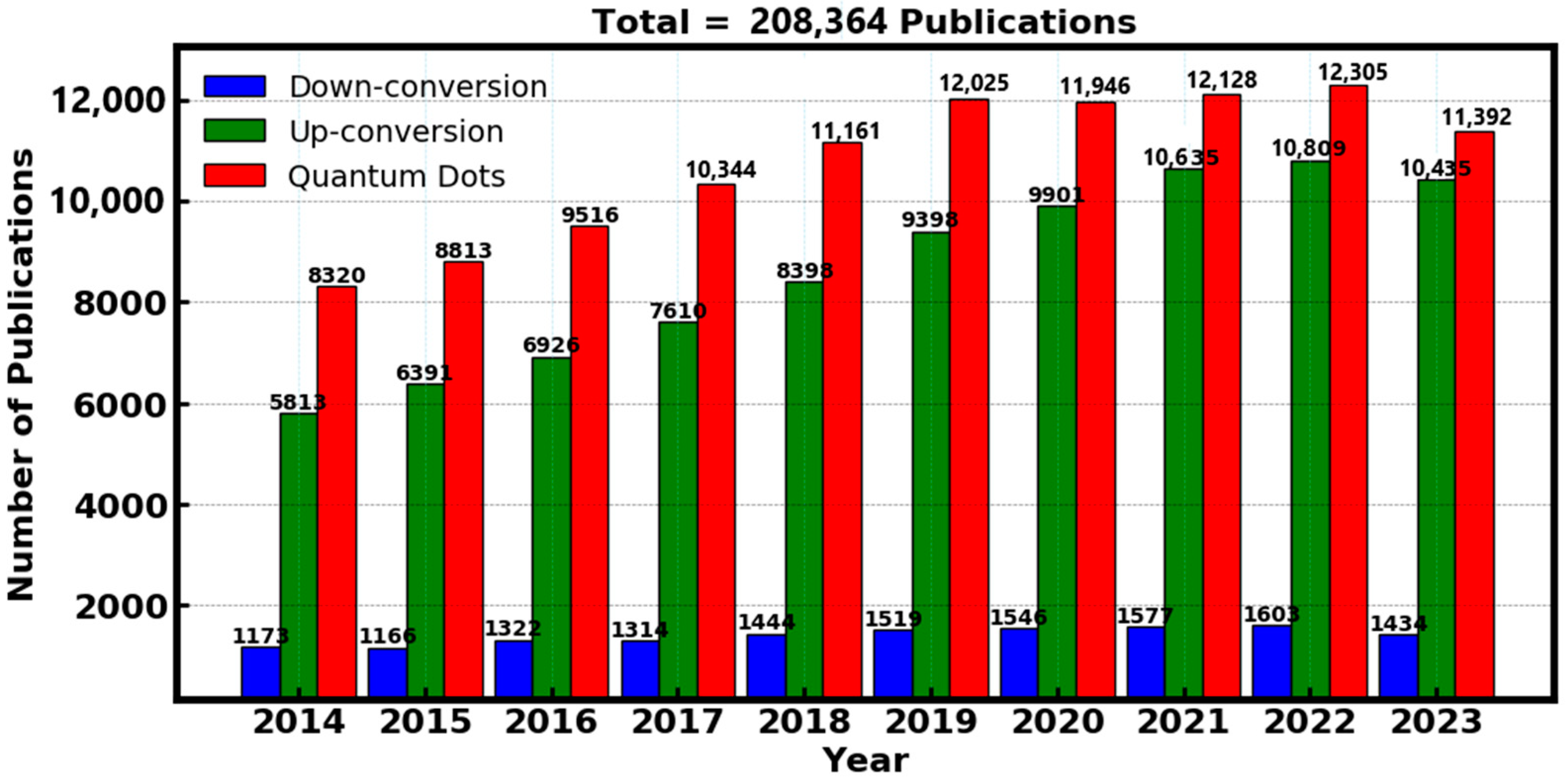

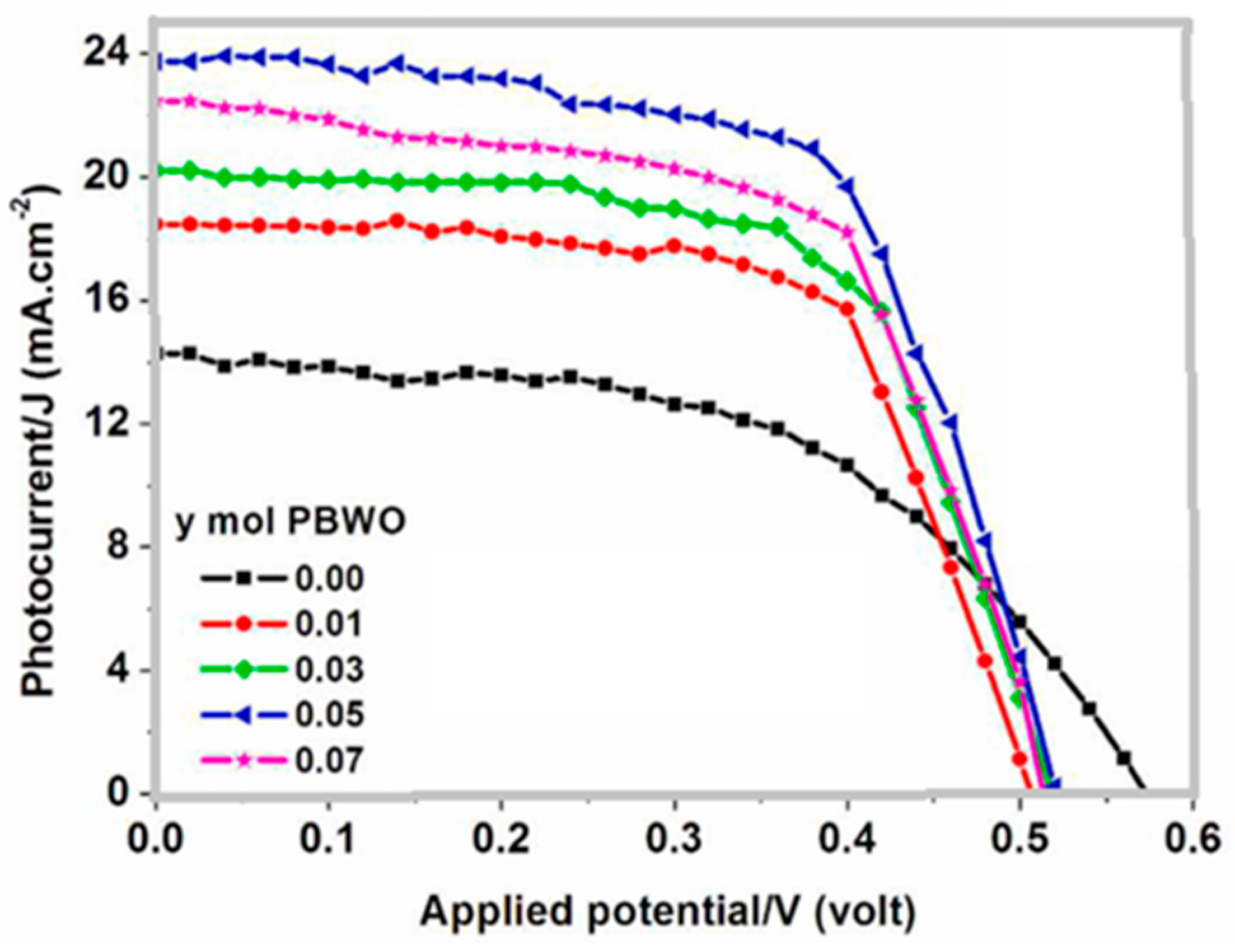
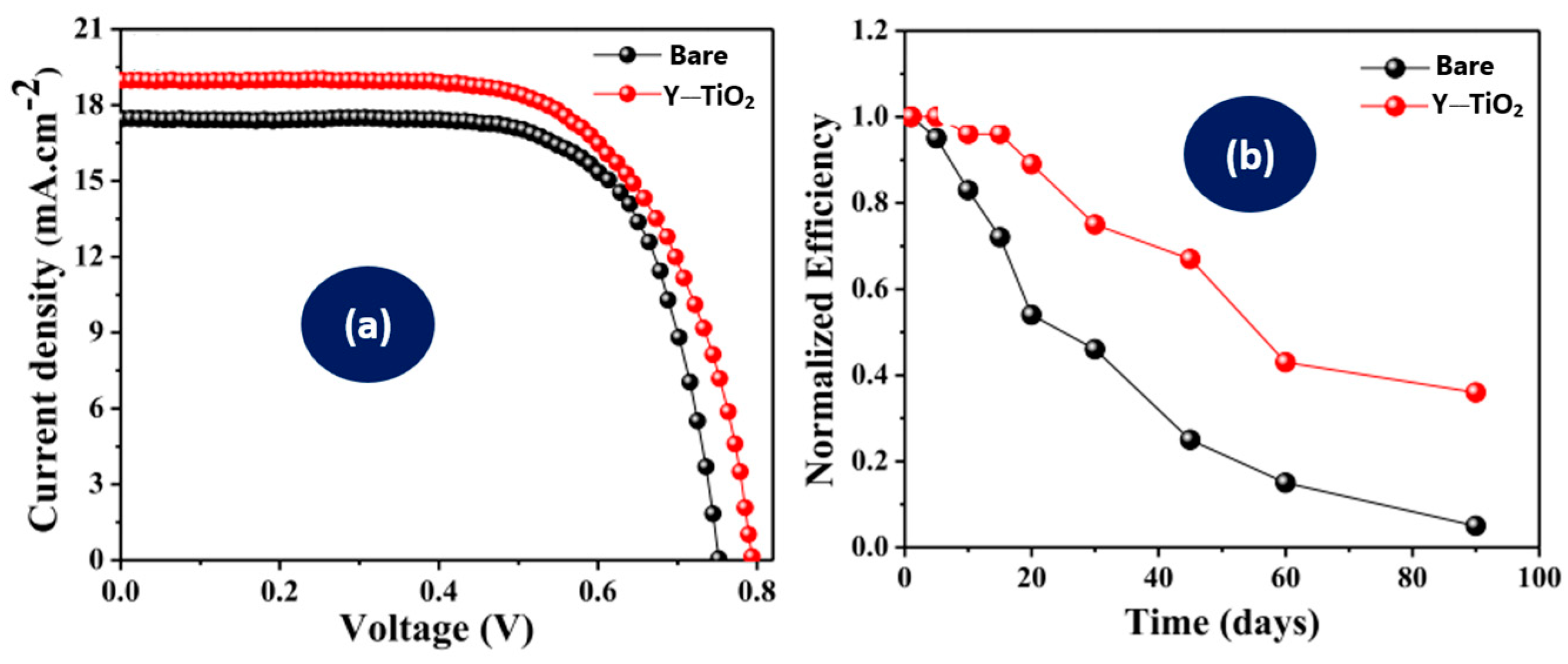

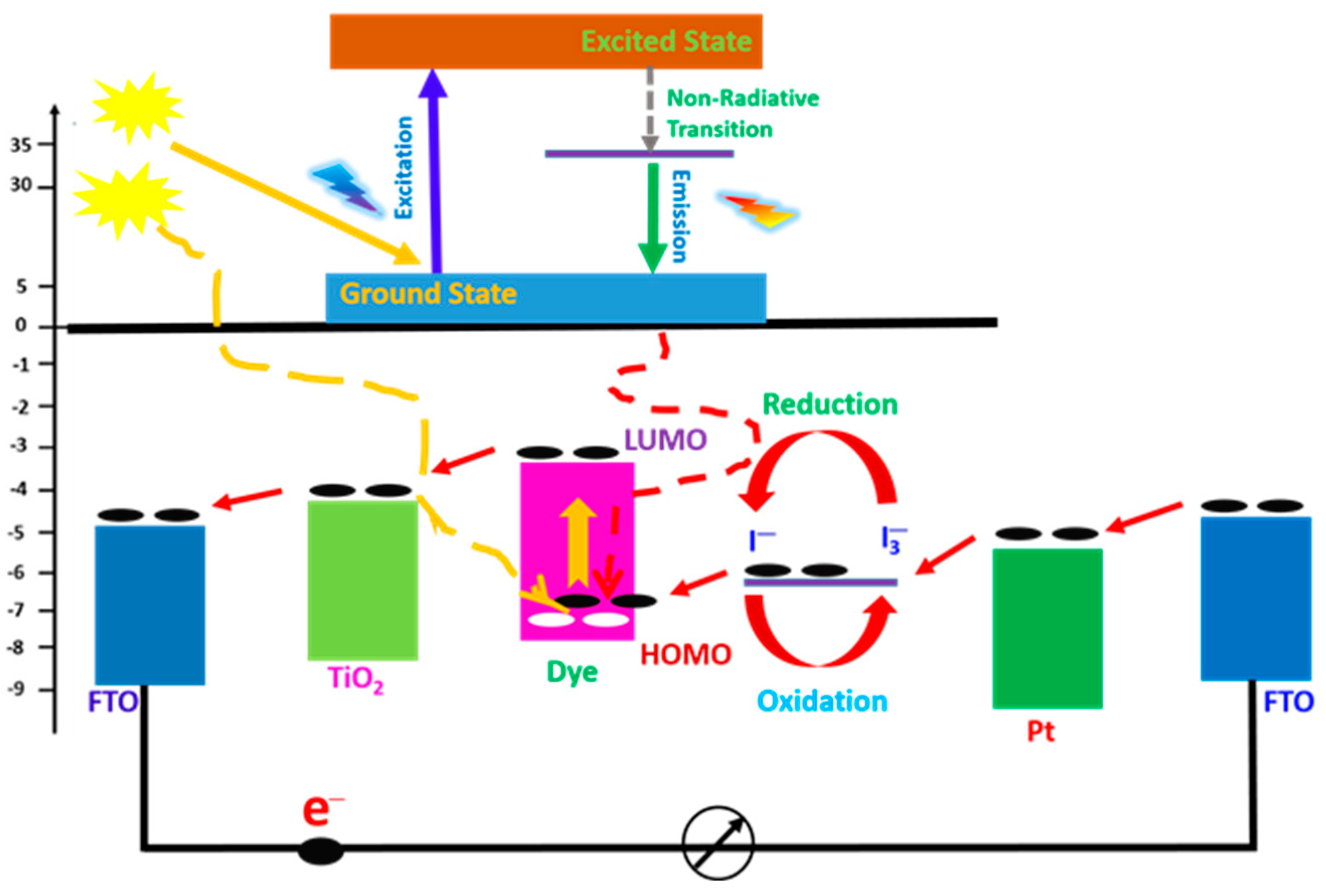
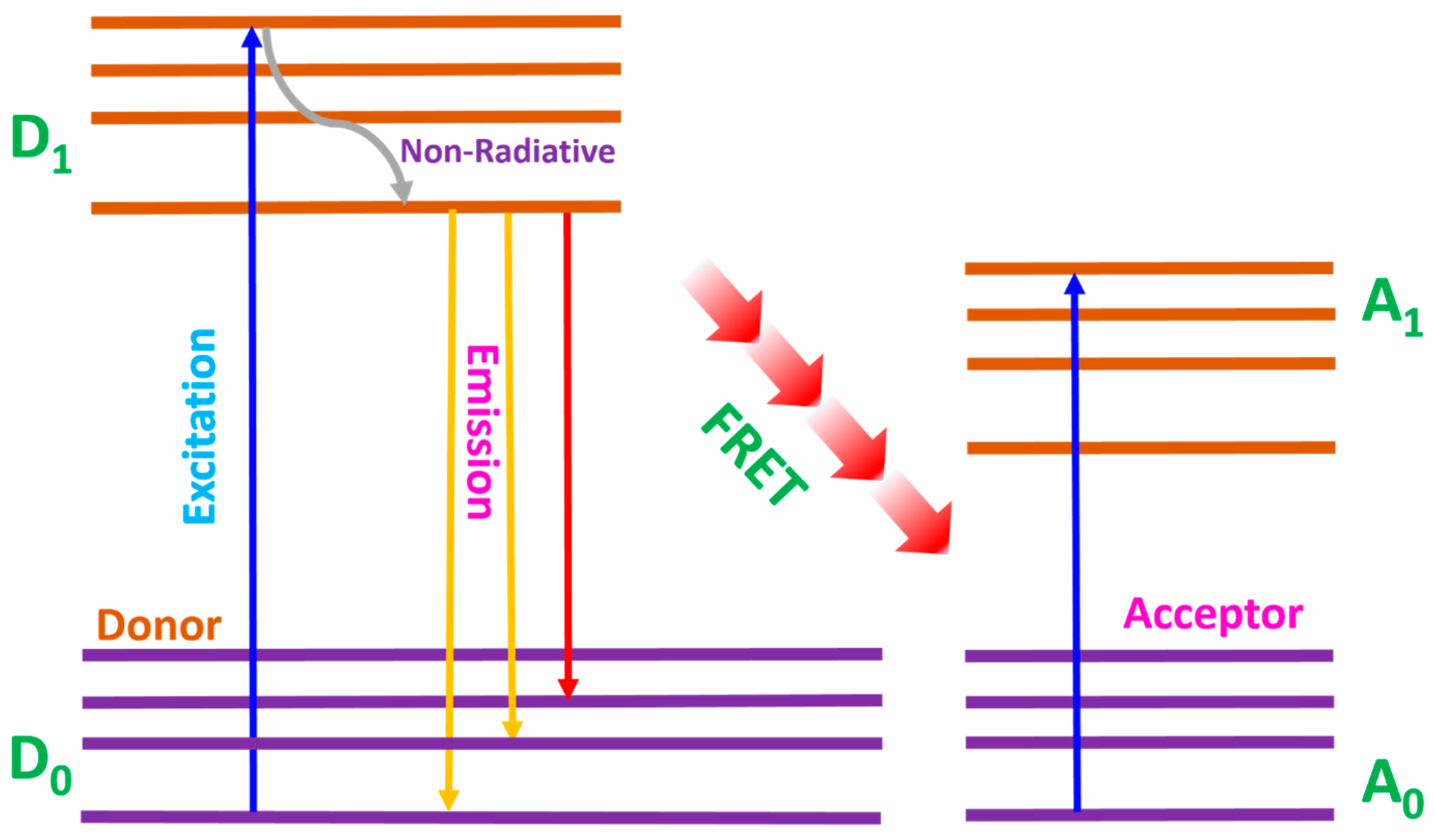
| y mol PBWO Electrodes | Voc | Jsc | Vmax | Jmax | FF | Dye Absorbed [M] × 10−5 | Eff (η) % |
|---|---|---|---|---|---|---|---|
| 0.00 | 0.572 | 14.40 | 0.343 | 12.15 | 0.51 | 2.35 | 4.17 |
| 0.01 | 0.504 | 18.57 | 0.350 | 16.78 | 0.62 | 3.47 | 5.87 |
| 0.03 | 0.514 | 20.22 | 0.364 | 18.16 | 0.63 | 5.06 | 6.51 |
| 0.05 * | 0.522 | 23.94 | 0.380 | 21.25 | 0.65 | 8.72 | 8.08 |
| 0.07 | 0.513 | 22.56 | 0.385 | 18.71 | 0.62 | 6.74 | 7.10 |
| Devices | Voc | Jsc [mA cm−2] | FF | η (%) |
|---|---|---|---|---|
| TiO2 | 0.752 | 17.49 | 0.677 | 8.9 |
| Y2O3:Ho3+(1%), Yb3+(5%)-TiO2 * | 0.791 | 18.97 | 0.655 | 9.82 |
| Jsc (mA/cm2) | Voc (V) | FF (%) | Efficiency (%) | |
|---|---|---|---|---|
| Bare TiO2 | 15.75 | 0.74 | 63 | 7.48 |
| NFS-GQDs modified TiO2 * | 22.6 | 0.79 | 70 | 11.7 |
| NFS-GQDs sensitized solar cell | 0.35 | 0.51 | 53 | 0.71 |
| Luminescent Materials | Voc (mV) | Jsc (mA/cm2) | FF (%) | η (%) | Reference |
|---|---|---|---|---|---|
| Y2CaZnO5:Er3+/Yb3+ | 710 | 13.28 | 64 | 6.01 | [63] |
| BaGdF5:Er3+/Yb3+ | 730 | 16.0 | 65.82 | 7.72 | [64] |
| LiYF4:Er3+/Yb3+ * | 660 | 22.16 | 72 | 10.53 | [65] |
| Lu2O3:Tm3+, Yb3+ | 757 | 13.41 | 65.3 | 6.63 | [66] |
| CaCe2(MoO4)4:Er3+/Yb3+ | 670 | 28.9 | 41 | 7.78 | [67] |
| Y2O3:Er3+, Yb3+ | 760 | 13.68 | 64.32 | 6.68 | [68] |
| Y2O3:Ho3+/Yb3+ | 710 | 21.9 | 51.29 | 7.59 | [69] |
| Luminescent Materials | Voc (mV) | Jsc (mA/cm2) | FF (%) | η (%) | Reference |
|---|---|---|---|---|---|
| Sm3+ | 690 | 16.71 | 46 | 5.31 | [70] |
| GdVO4:Dy3+ | 680 | 17.40 | 58 | 6.88 | [71] |
| CeVO4:Dy3+ | 710 | 18.18 | 56 | 7.21 | [72] |
| BaSnO3:Sm3+ | 810 | 0.62 | 72 | 0.36 | [73] |
| LaVO4:Dy3+ | 650 | 9.35 | 64 | 3.8 | [74] |
| Y2WO6:Eu3+ | 757 | 12.3 | 43 | 3.9 | [75] |
| Y3Al5O12:Ce3+ * | 780 | 14.5 | 74 | 8.35 | [76] |
| MgAl2O4:Eu3+ | 642 | 14.8 | 62 | 4.8 | [77] |
| SrAl2O4:Eu3+ | 777 | 15.68 | 58.78 | 7.16 | [78] |
| (Sr, Ba, Eu)2SiO4 | 830 | 10.23 | 70.6 | 5.97 | [79] |
| Y2O3:Eu3+, Gd3+ | 766 | 13.33 | 62.4 | 6.37 | [80] |
| Luminescent Materials | Voc (mV) | Jsc (mA/cm2) | FF (%) | η (%) | Reference |
|---|---|---|---|---|---|
| GQD2 | 653 | 22.62 | 53 | 7.82 | [81] |
| BP/RPQDs | 718 | 16.3 | 68.5 | 8.02 | [82] |
| C100-CQDs | 404 | 0.306 | 44 | 0.0544 | [83] |
| TiCl4+N719+GQDs | 660 | 4.11 | 73 | 2.00 | [84] |
| PANI-GQDs | 440 | 9.3 | 39.1 | 1.6 | [85] |
| NCQD DSSC * | 710 | 18.13 | 63.7 | 8.75 | [86] |
Disclaimer/Publisher’s Note: The statements, opinions and data contained in all publications are solely those of the individual author(s) and contributor(s) and not of MDPI and/or the editor(s). MDPI and/or the editor(s) disclaim responsibility for any injury to people or property resulting from any ideas, methods, instructions or products referred to in the content. |
© 2024 by the authors. Licensee MDPI, Basel, Switzerland. This article is an open access article distributed under the terms and conditions of the Creative Commons Attribution (CC BY) license (https://creativecommons.org/licenses/by/4.0/).
Share and Cite
Onah, E.H.; Lethole, N.L.; Mukumba, P. Luminescent Materials for Dye-Sensitized Solar Cells: Advances and Directions. Appl. Sci. 2024, 14, 9202. https://doi.org/10.3390/app14209202
Onah EH, Lethole NL, Mukumba P. Luminescent Materials for Dye-Sensitized Solar Cells: Advances and Directions. Applied Sciences. 2024; 14(20):9202. https://doi.org/10.3390/app14209202
Chicago/Turabian StyleOnah, Emeka Harrison, N. L. Lethole, and P. Mukumba. 2024. "Luminescent Materials for Dye-Sensitized Solar Cells: Advances and Directions" Applied Sciences 14, no. 20: 9202. https://doi.org/10.3390/app14209202







